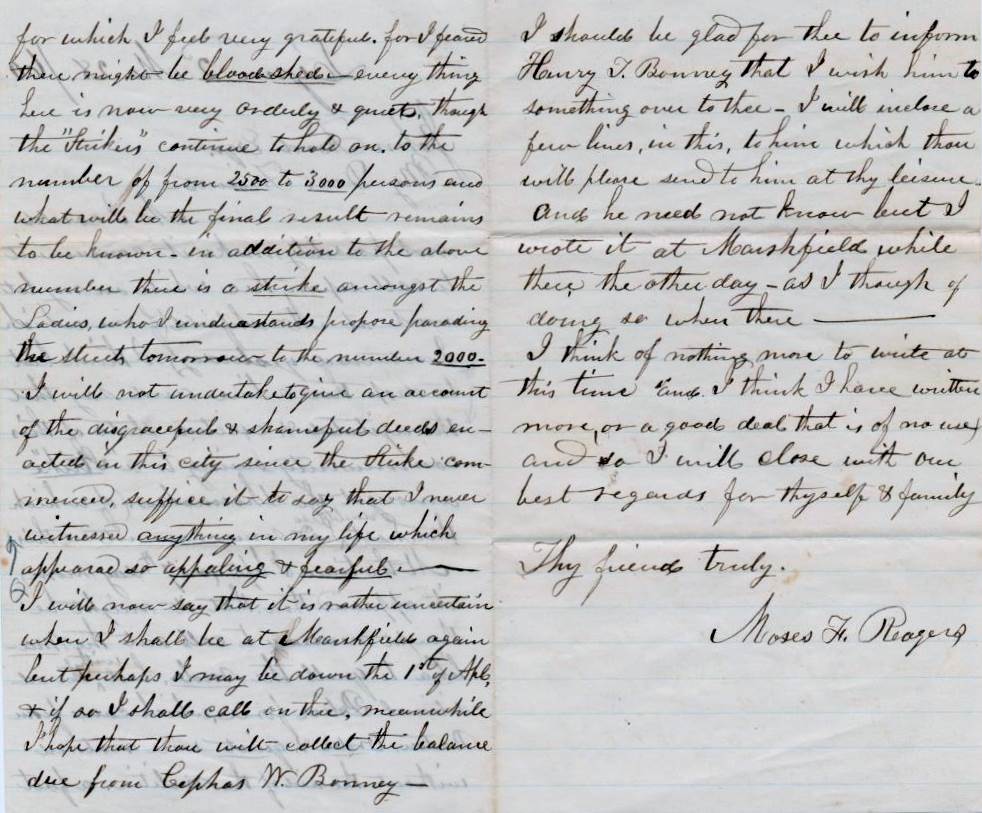By Susan Martin, Collection Services
The MHS just acquired a letter written by an eyewitness to the historic shoemakers’ strike in Lynn, Mass. in 1860. I decided to dig into the story and, as usually happens, learned much more than I anticipated. It’s remarkable how much history can be represented in a single document.

Moses Folger Rogers (1803-1886) was a Quaker living in Lynn. Most of his 6 March 1860 letter to John Ford of Marshfield, Mass. is dedicated to the biggest story in town, the shoemakers’ strike then underway. Lynn was a major center for the manufacture of shoes. Labor unrest in that industry had been growing for many reasons—increased mechanization, market glut, the economic crisis of 1857—all of which resulted in record low wages.
Workers took to the streets on George Washington’s birthday, 22 February 1860, and the strike lasted for several weeks. Newspapers covered it extensively, and many historians have written about it, but it’s hard to overstate the value of first-hand accounts like this one.
Rogers was not pleased. He lamented the “agitated & excited state of this community.” A week before, it had appeared “that it might be thought necessary to call out the malitia to quell the mob, but with the additional Police force, which came from Boston, order & quiet were restored without the aid of the malitia, a fact for which I feel very grateful, for I feared there might be blood shed – every thing here is now very orderly & quiet, though the ‘Strikers’ continue to hold on, to the number of from 2500 to 3000 persons and what will be the final result remains to be known.”
There had been some violence, including clashes with police and seizures of goods. But it subsided after the first few days, and the rest of the strike consisted of meetings, marches, rallies, and other demonstrations of peaceful solidarity. It was the largest strike in American history up to that time, spreading across New England and involving tens of thousands of workers.
But it wasn’t just the possibility of bloodshed that worried Moses Rogers. He was also dismayed by the active involvement of women in the uprising. In fact, the Lynn strike was notable for the vital role women played in both planning and execution. It makes sense—women were integral to the shoemaking industry. They worked at home as “binders,” or hand stitchers, or operated sewing machines in factories. In his book Class and Community, Alan Dawley wrote: “Without the action of women, it is questionable whether the strike would have occurred at all, and certainly without them it would have been far less massive in its impact.”
But Rogers described these developments in a horrified tone with lots of outraged underlining: “In addition to the above number there is a strike amongst the Ladies, who I understand propose parading the streets tomorrow to the number 2000.” The march did happen, and in dramatic fashion. Thousands participated, including 800 women, in the midst of a snowstorm. Frank Leslie’s Illustrated Newspaper published an illustration.

Rogers finished his diatribe with a flourish: “I will not undertake to give an account of the disgraceful & shameful deeds enacted in this city since the Strike commenced, suffice it to say that I never witnessed anything in my life which appeared so appaling & fearful.” His response to the strike was not atypical, judging by newspaper accounts. But the strikers had substantial support from townspeople, Lynn’s Bay State newspaper, and even Abraham Lincoln, who was campaigning for president at the time. (The shoemakers’ demonstrations, protest songs, and slogans were infused with antislavery rhetoric.)
Although the Lynn strikers had some temporary political success, ousting most of the city government in the next election, they ultimately failed as negotiations fell apart and workers’ differences proved insurmountable. When the Civil War broke out a year later, attention shifted away from the issue, and war-time demand for manufactures accelerated. However, the Lynn shoemakers’ strike was a watershed moment in American history, remarkable for its size and scope, a clash of old and new systems that foreshadowed labor disputes of the next 150 years.
——————-
Select sources:
– Dawley, Alan. Class and Community: The Industrial Revolution in Lynn. Cambridge, Mass.: Harvard University Press, 1976.
– Faler, Paul G. Mechanics and Manufacturers in the Early Industrial Revolution: Lynn, Massachusetts, 1780-1860. Albany, N.Y.: State University of New York Press, 1981.
– Juravich, Tom, William F. Hartford, and James R. Green. Commonwealth of Toil: Chapters in the History of Massachusetts Workers and Their Unions. Amherst, Mass.: University of Massachusetts Press, 1996.
– Lewis, Alonzo and James R. Newhall. History of Lynn, Essex County, Massachusetts: Including Lynnfield, Saugus, Swampscot, and Nahant. Boston: John L. Shorey, 1865.
– Melder, Keith E. “Women in the Shoe Industry: The Evidence from Lynn.” Essex Institute Historical Collections 115.4 (October 1979): 270-287.

